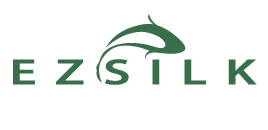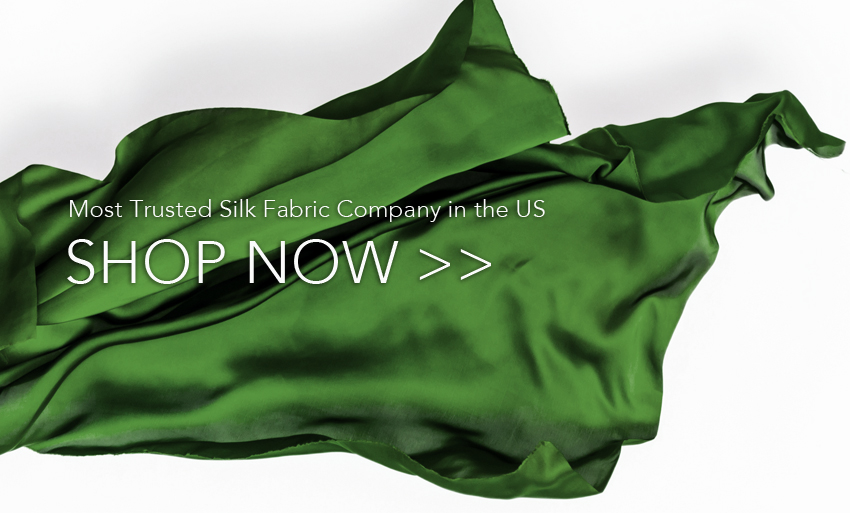
EZSilk is Most Trusted Silk Fabric Company in the United States.

Silk Fabric More Than 850,000 yards & Printed Silk in the USA
--- Solid Silk Fabric Category, Carrying 100 types of silk fabric, Serving 20 years ---
|
EZSilk is the most trusted silk fabric company in the U.S., serving more than 20 years. All silk fabric is made by A+ silk weaved greige goods, result in great hand feel and expose excellent colors, 12,000 colors available in stock.
We offer FREE Silk Color Card and FREE Silk Fabric Sample Swatches by regular mail anywhere in the United States for FREE. We carry high-end silk fabrics more than 850,000 yds in stock in the United States.
Our silk fabrics are divided into 100 different types. Find out your right silk fabric from our website.
|
Custom Silk Scarf Manufacturer, Printed in Italy & Made in USA
|
|
Silk FabricThe finest silk fibers, and most of what we use today, are produced by "cultivated" silkworms grown in a controlled environment. The worms are fed a diet of mulberry leaves and increase their body size 10,000 times in their short life span. Once the cocoon is spun and before the worm hatches through the silk into a moth, the cocoon is soaked in hot water then unraveled, producing filaments that can be up to a mile long in size. The raw silk is then processed to remove the sericin - the natural "gum" that protects the fibers and causes them to stick to each other as the cocoon was spun. Silk is a protein fiber, similar to wool or to human hair. It is only natural for silks to have some irregularities – sometimes called "slubs". This is the nature of the 100% silk fabric. Silk that has been processed can be woven or knit into a variety of fabrics. Silk will shrink, so if you are using it to construct clothing, be sure to preshrink it. Silk often has a wonderful feel, (referred to as a "hand"), and an almost iridescent sheen that makes us think of luxury. The weight of silk is shown as "mm" – pronounced "mommy" – and varies within the different types of silk. The following list of various types of silk may help you understand some of the qualities of each: |
Silk Chiffon FabricOften the lightest weight and most diaphanous of the silks, silk chiffon is also the most see-through. It creates the "billows" of fabric that add dimension to garments, but generally requires some kind of lining or backing unless it's used for scarves. Silk chiffon fabric can be dyed to almost any shade. Under a magnifying glass it resembles a fine net or mesh which gives chiffon some see through properties. |
Silk Georgette (GGT) FabricSilk Georgette (GGT) fabric is a sheer, lightweight, dull-finished crepe fabric named after the early 20th century French dressmaker Georgette de la Plante. Silk GGT (Georgette) fabric is made in solid colors and prints, and is used for blouses, dresses, evening gowns, and trimmings. It is springier and less lustrous than the closely related chiffon. Silk georgette fabric comes in various weights from light to heavy version. |
Silk Habotai FabricSilk habotai fabric is a lightweight, sheer, plain-weave fabric. It's sometimes referred to as habutai, or habotai, or pongee. It is one of the less expensive and more commonly available silk fabrics. Silk habotai can often be found as light as 5 mm and as heavy as 12 mm. Most of our scarves are made of 8 mm Habotai. When purchasing for clothing construction, or purchasing ready-made clothing, this fabric is not recommended for fitted garment styles because the seams will tear from the stress. |
Silk Crepe de Chine (CDC) FabricSilk Crepe de Chine or silk cdc fabric is a lightweight fabric made by twisting some fibers clockwise and others counterclockwise. The twisted fibers are then woven in a plain-weave fabric, but it's the twisted fibers, not the weave, that gives crepe its distinctive "pebbly" look and feel rather than a shiny luster. Both sides of the fabric look and feel the same. Many scarves are made of Silk Crepe de Chine, often in the 12mm to 16mm range. When purchasing ready-made clothing or considering this fabric for sewing, avoid using it in tailored styles because the fabric is too soft to hold a structured shape. |
Silk Charmeuse FabricGenerally, when we think of traditional silk fabric, this is the fabric we have in mind. The back of the fabric is a flattened crepe while the front is a shimmery satin weave. Silk charmeuse fabric has even more drape than crepe de chine and works well for scarves, blouses and lingerie. Occasionally we will offer scarves in silk charmeuse. |
Silk Stretch Span FabricSilk stretch fabric has all the softness and bright luster of silk fabric, but with spandex added for superior stretch and comfortable movement. Usually it contains 90% ~ 95% silk with 5% ~ 10% spandex portions. Silk stretch fabric usually comes as silk stretch charmeuse, silk stretch cdc, silk stretch ggt, silk stretch chiffon and silk stretch 4-ply. Some called it silk lycra fabric or silk span fabric. |
Silk Organza FabricSilk organza fabric is a thin, plain weave, sheer fabric traditionally made from a few thousand years ago. Silk organza is woven by a number of mills along the Yangtze River and in the province of Zhejiang in China. A coarser silk organza is woven in the Bangalore area of India. Deluxe silk organzas are woven in France and Italy. Organza fabric is mainly used for bridalwear and eveningwear. In the interiors market it is used for effects in bedrooms and between rooms. Double-width organzas in viscose and acetate are used as sheer curtains. |
Silk Twill FabricSilk fabric has twill pattern on it, we used to call it silk twill. Twill is a type of textile weaves with a pattern of diagonal parallel ribs, in contrast with a satin and plain weave. This is done by passing the weft thread over one or more warp threads and then under two or more warp threads and so on, with a "step" or offset between rows to create the characteristic diagonal pattern. Because of this structure, twills generally drape well. There is also silk deep twill fabric, a little more wider twill texture verison, weigth of 19mm mid-weight range fabric. |
Silk Dupioni FabricSilk dupioni fabric has much more prominent slubs (those crosswise irregularities in texture) and is the thicker of the two materials, almost comparing to the feel of a light or medium weight taffeta. Dupioni has an almost rustic look to it in weave only, but the incredible sheen and vibrant colors that silk dupioni is known for can render it suitable for prom dresses, bridal gowns (when paired with an appropriate lace), dazzling women’s suits, and even baby outfits. Silk dupioni fabric is a medium to heavy weight fabric, term derives from the Italian word for double, referring to the silk filament from cocoons that either interlocked or are so cramped that they must be spun together. This produces a tought thread with smaill, irregular slubs. The silk is usually dyed in bright colors and may be woven with an iridescent, two tone color sheen that is created with warp threads of one color and weft threads of another. For ages, silk shantung and dupioni fabrics have been accepted as the creme’ de la creme’ of fashion fabric. |
Silk Shantung FabricSilk shantung fabric is very similar to silk dupioni group. Silk Shantung has hardly any slubs, and those that it does have will be much smaller in thread width than a silk dupioni. In addition, while the silk shantung will still have a fair amount of body and that lovely crispness, it will usually be much thinner than the dupioni and will therefore be suitable to more delicate garments. Silk shantung can almost appear flowing, and is the perfect “happy-medium” between a drapey silk charmeuse and a stiff silk dupioni or taffeta. Besides the popular uses of silk in home decorating and quilting projects, silk shantung is terrific for evening wear, flower girls’ dresses, bridal gowns or sashes, fabric flowers, First Ladies’ gowns, or any special occasion that calls for an exquisite outfit. Those luxurious, textured fabrics with the crisp feel and brilliant lustre are often seen in formal gowns, party suits, wedding attire, and the occasional heirloom christening gown. Besides, name of silk dupioni was from Italian and shantung was from Chinese. |
Silk Jacquard (JQD) FabricSilk Jacquard (JQD) fabric loom is a mechanical loom and the loom was controlled by a "chain of cards", a number of punched cards, laced together into a continuous sequence. Multiple rows of holes were punched on each card, with one complete card corresponding to one row of the design. Several such paper cards, generally white in color, can be seen in the images below. Chains, like the much later paper tape, allowed sequences of any length to be constructed, not limited by the size of a card. We have numerous silk Jacquard (JQD) patterns with enormous color collections. |
Silk Taffeta FabricSilk taffeta fabric is a crisp, smooth, plain woven fabric made from silk. The word is Persian in origin and means "twisted woven." It is considered to be a "high-end" fabric, suitable for use in ball gowns, wedding dresses, and interiors for curtains or wall covering. It is also widely used in the manufacture of corsets and corsetry: it yields a more starched-like type of cloth that holds its shape better than many other fabrics. An extremely thin, crisp type of taffeta is called paper taffeta. There are two distinct types of silk taffeta: yarn-dyed and piece-dyed. We carry piece-dyed and have 21 colors in 100% silk taffeta fabric. |
About Us |
Solid Silk Fabric |
Printed Silk Fabric |
Custom Silk Scarf Manufacturer | |
EZSilk 144 Silk Color Card |
Privacy Policy |
Contact Us |